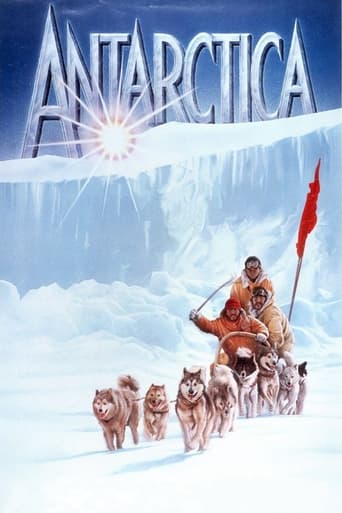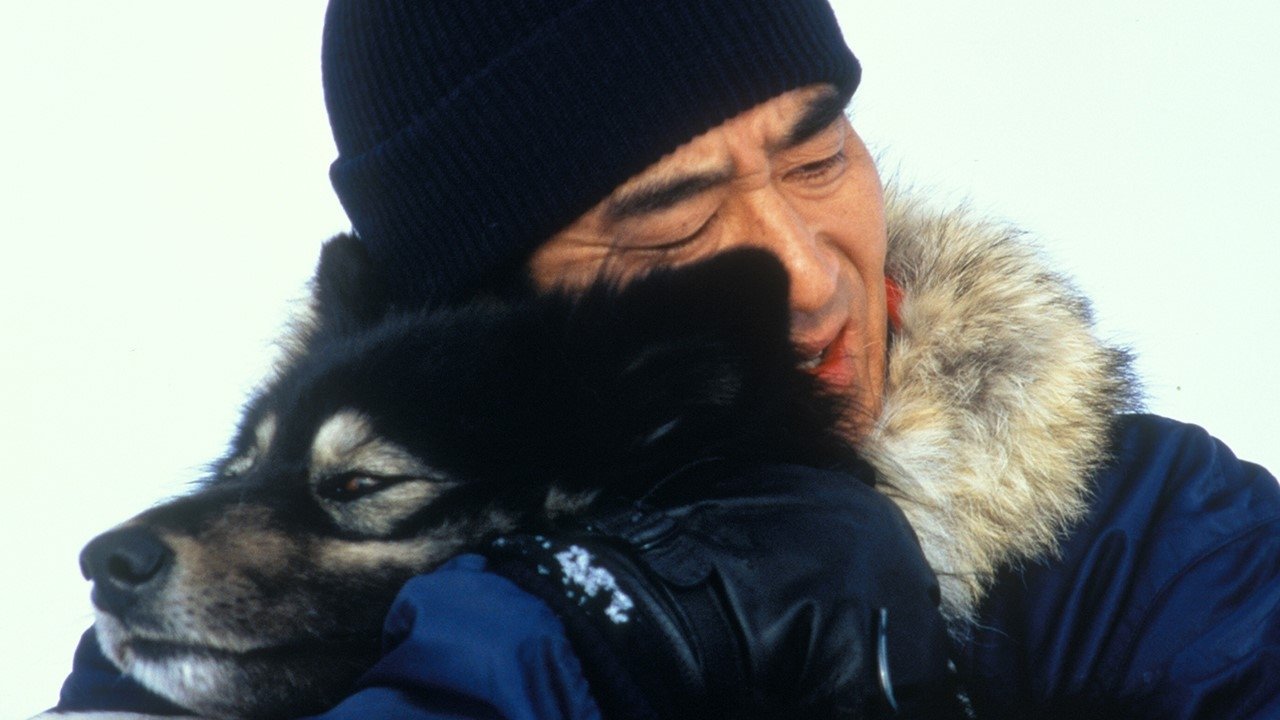dvc5159
Antarctica is a white land of pure isolated beauty, and Koreyoshi Kurahara's "Antarctica", perhaps the best animal film I've seen, and also one of the greatest of all adventure films, ensures that thoroughly. The majestic white landscape of nature at its purest set the stage for its story about a group explorers who bond emotionally over a period of time during their journeys, only to find most of themselves stranded there following a hazardous winter storm, where they are forced to fend off threats from both nature itself and its creations.What makes Kurahara's film intriguing is that 12 of the explorers aren't human. They are snow dogs, mostly trained by their respective owners in Hokkaido, Japan; and two others raised on the frozen continent itself. They get subjected to winter storms, the longest of nights and the unpredictable terrain of Antarctica as they scamper around the barren land looking for food to survive as long as they can. Meanwhile, the two scientists who bond with them (one of them played by the renowned Ken Takakura) relentlessly regret their decision to abandon the dogs that they have come to bond with during their expedition there, even though they know they do not have a choice in the matter. Takakura's character guilts so much that he resorts in apologizing to each previous owner personally. In a heart-wrenching scene, two girls forcibly return a puppy (born to one of the dogs in Antarctica) intended to be an apology gift.Kurahara's masterstroke is that he makes the dogs the core of this survival tale, and he does so as if the camera were a watchful eye over the lost souls, lingering onwards when tragedy suddenly strikes. It can be argued that the film is a docudrama, with a helpful and non-intrusive narrator filling in the blanks at the right moments. It can also be called a visually spectacular epic as the beautiful, sweeping cinematography swoops over the white land and blue seas, the kind of shots that documentaries can never get. There are many magnificent scenes of startling beauty and skill to be appreciated in the film besides its powerful thematic content.The humans' presence is brief but serve to highlight mankind's love for its own kind while forgetting nature's other creatures - rendering them expendable. Takakura and the rest of the actors do a great job in conveying the reality of the situation as naturally as real people would. This commentary is briefly explored as Kurahara wastes no time in returning to the dogs' situation.The cinematographer Akira Shiizuka's camera pulls the audience straight into the film, joining the dogs on their quest for survival amidst the desolate yet overwhelmingly beautiful land. It becomes a character of its own, as per Vangelis' fantastic music score, which chimes perfectly as the heart and soul of the journey, like an angel giving strength and encouragement.It is common sense that dogs work as a family when grouped and protect who they love. Having owned two dogs, they are both protective of their owners and friends. Though a dog in the movie prefer to be venturing alone, the rest of the survivors band together and search for food, shelter, anything. Absolutely heartbreaking (and for dog lovers, emotionally shattering) scenes occur throughout the ordeal, all of them a result of nature's fury.This film was remade by Disney and Frank Marshall in 2006 as "Eight Below", with Paul Walker more or less as Takakura's role. Although a noble effort to recapture the essence of the original, it sentimentalizes numerous moments from the original too much that they becomes distractions. I could say the same for other Hollywood animal movies who try to connect to the audience by ways of sentimentality - even very effective ones like "War Horse" and "Free Willy". "Antarctica" doesn't aim for sentimentality - the film was based on a true story, and Kurahara shows its natural strength as it is - which tremendously adds to the emotional impact of the film. I merely find Hollywood animal films touching at best, but this one struck a chord with me and moved me with no expectations. The film runs lengthily at 2 hours and 23 minutes, yet not a minute goes by that I wasn't enthralled at, not even during the human moments. I can only wonder why Criterion (or Disney even) did not pick the film up for a high-definition Home Video release, as that's the best way to watch it besides cinemas. It's not a kids' movie but it's something kids should watch. I only hope they and their parents will enjoy the experience as much as I loved it.
marji1919
I saw the movie on TV in the late 80's when I was living in Japan and it has always stayed with me. One reason is that my friend, Karla, said it was from Alaska. This was not logical to me because the harnesses on the sleds were "Eastern Arctic", not Western Arctic. The Eastern Arctic harness is like a fan, the Western Arctic/Alaskan style is the straight line with two dogs running side by side with a lead dog.Another reason is that I adore dogs, and had always asked my father to bring back a Canadian Eskimo Dog (a specific breed) when he traveled north to the Arctic (He refused). And, finally, the cinematography is beautiful. It was a perfect movie to watch with my limited (almost non-existent) Japanese! The images of the landscape have haunted me since that night in Tokushima in 1987.
sol1218
**SPOILERS*** True story that took place during the Geographical year 1957-58, in the freezing ice and snow of Anarctica, by a Japanese expedition team on their journey to the Antarctic Mount. Batnnutan and back;a trek of some 500 miles.Leaving Showa Base with a team of 16 tough Sakhalin sled dogs the three man expedition of geologist Ushioda meteorologist Ochi and Dr. Ozawa had no trouble reaching their main objective, Mount. Batnnutan. On the way back they ran into heavy snows and fog that caused them to go snow-blind and get lost. Helpless with no way of getting back to their home base the men unleashed two of their sled dogs, Taro & Jiro, who reached Showa Base and brought back a rescue party to save both the three men and 15 sled dogs. At the base it's reported that the weather had gotten so severe that they would have to abort the expedition and return back to their icebreaker, the Soya, that would take them back home to Japan. Unable to bring them along the men were forced to leave the dogs, including the two who rescued them Taro & Jiro, at the now deserted Showa Base and; thus leave them to the bitterly cold Antarctica winter that was just starting to set in.Heartwarming and true story of men and dogs and how left on their own the sled dogs, answering the call of the wild, formed a wolf-like pack that for over a year survived everything that the inhospitable Antarctic winter had to offer them; a frozen and agonizing death.Beautifully photographed with incredible wide angle shots that showed the audience how vast and eerie the Antarctic really is. We see the dogs roaming around like a bunch of dark and unrecognizable black specks in the limitless white background. "Antarctica" also has a number of fascinating views of the Southern Lights, the Borealis Australis, as they illuminate and light up the cold and dark Antarctic winter night. By the time the winter was over ,in September 1958, the Antarctic spring set in with the ice packs breaking apart and causing a number of the surviving sled dogs to fall into the open waters where they drowned. Back home in Japan both Ushida and Ochi were heart sick over leaving the dogs behind and a year. later going on another Antarctic expedition mostly to find and take back the frozen bodies of the sled dogs, that were like members of their family. The two never expected to find out just how wrong they were in underestimating their courageous and unconquerable canine friends.Not exactly a "Lassie Come Home" type of movie the film "Antartica" shows how deep the bind is between man and his best friend and companion the dog and it will really touch you when at the end of the movie. With all hope gone, for the dogs left behind, like a winter mirage Taro and Jiro materialized out of the snow to the shock and delight, to the point of tears, of those who so sadly were forced to leave them behind and to face certain death.
slward
I accidently stumbled upon this movie and was immediately ensconced in its story line, scenery and cast of characters (primarily the dogs). The subtitles did not distract from the films Japanese dialogue. This semi-documentary style added authenticity to the fact based plot. The human actors may have been the catalyst for this poignant retelling, but the dogs were indeed the glue that held this film together. Given the fact that most of the sets were filmed on location, the dogs performed exceptionally well and held this viewer fast.The misadventures that the dogs endured during their separation from their owners were deeply touching and powerful. One would have to have ice water flowing through one's veins to be unmoved from this film. Although hard to find, I heartily recommend the movie for age groups of 12 or older. The violence is implied rather than portrayed but none-the-less quite intense.


 AD
AD

